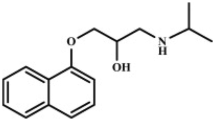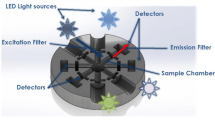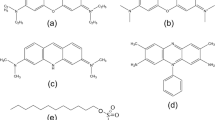Abstract
Fluorescence properties of N, N′-bis(salicylidene) trans 1, 2-diaminocyclohexane (H 2 L) is used to probe the anionic (SDS), cationic (CTAB) and nonionic (TX-100) micelles as well as in serum albumins (BSA and HSA) and chicken egg white lysozyme (LYZ) by steady state and picosecond time-resolved fluorescence spectroscopy. The fluorescence band intensity was found to increase with concomitant blue-shift with gradual addition of different surfactants. All the experimental results suggest that the probe molecule resides in the micelle-water interface rather than going into the micellar core. However, the penetration is more towards the micellar hydrocarbon core in nonionic surfactant (TX-100) while comparing with ionic surfactants (SDS and CTAB). Several mean microscopic properties such as critical micelle concentration, polarity parameters and binding constant were calculated in presence of different surfactants. The decrease in nonradiative decay rate constants in micellar environments indicates restricted motion of the probe inside the micellar nanocages with increasing fluorescence emission intensity and quantum yields. Further in this work, we also investigated the interaction behavior of the probe with different proteins at low concentrations under physiological conditions (pH = 7.4). Stern–Volmer analysis of the tryptophan (Trp) fluorescence quenching data in presence of probe reveals Stern–Volmer constant (Ksv) as well as bimolecular quenching rate constant (Kq). The binding constant as well as the number of binding sites of the probe with proteins were also monitored and found to be 1:1 stoichiometry ratio.













Similar content being viewed by others
References
Fendler HJ (1982) Membrane mimetic chemistry. Wiley-Interscience, New York
Sakthivel T, Florence AT (2003) Dendrimers & dendrons: facets of pharmaceutical nanotechnology. Drug Deliv Technol 3:73–78
Anwer K, Meaney C, Kao G, Hussain N, Shelvin R, Earls RM, Leonard P, Quezada A, Roland AP, Sullivan SM (2000) Cationic lipid-based delivery system for systemic cancer gene therapy. Cancer Gene Ther 7:1156–1164
Kalyansundaram K (1991) Photochemistry in organized and constrained media, Ramamurthy V (ed). VCH Publishers, New York
Kalyanasundram K (1987) Photochemistry in microheterogeneous systems. Academic, New York
Mittal KL, Lindman B (1994) Surfactants in solution, vols 1–3. (Ed.). Plenum, New York
Mallick A, Halder B, Maity S, Chattopadhyay N (2004) Constrained photophysics of 3-acetyl-4-oxo-6,7-dihydro-12H indolo-[2,3-a] quinolizine in micellar environments: a spectrofluorometric study. J Colloid Interface Sci 278:215–223
Wagner BD (2009) The use of coumarins as environmentally sensitive fluorescent probes of heterogeneous inclusion systems. Molecules 14:210–237
Turro NJ, Grätzel M, Braun AM (1980) Photophysical and photochemical processes in micellar systems. Angew Chem Int Ed Engl 19:675–696
Menger FM (1979) The structure of micelles. Acc Chem Res 12:111–117
Adams PA, Berman MC (1980) Kinetics and mechanism of the interaction between human serum albumin and monomeric haemin. Biochem J 191:95–102
Kragh-Hansen U (1981) Molecular aspects of ligand binding to serum albumin. Pharmacol Rev 33:17–53
Baker ME (2002) Albumin, steroid hormones and the origin of vertebrates. J Endocrinol 175:121–127
Cater DC, Ho JX (1994) Structure and ligand binding properties of human serum albumin. Adv Protein Chem 45:153–203
Olson RE, Christ DD (1996) Plasma protein binding of drugs. Annu Rep Med Chem 31:327–337
Guo M, Zou JW, Yi PG, Shang ZC, Hu GX, Yu QS (2004) Binding interaction of gatifloxacin with bovine serum albumin. Anal Sci 20:465–470
Naik PN, Chimatadar SA, Nandibewoor ST (2010) Pharmacokinetic study on the mechanism of interaction of sulfacetamide sodium with bovine serum albumin: a spectroscopic method. Biopharm Drug Dispos 31:120–128
Naik PN, Chimatadar SA, Nandibewoor ST (2009) Study on the interaction between antibacterial drug and bovine serum albumin: a spectroscopic approach. Spectrochim Acta Part A 73:841–845
Gu AQ, Zhu XS, Hu YY, Yu SH (2007) A fluorescence spectroscopic study of the interaction between epristeride and bovin serum albumin and its analytical application. Talanta 73:668–673
Zhang HM, Lou K, Cao J, Wang YQ (2014) Interaction of a hydrophobic functionalized PAMAM dendrimer with bovine serum albumin: thermodynamic and structural changes. Langmuir 30:5536–5544
Kratochwil NA, Huber W, Muller F, Kansy M, Gerber PR (2002) Predicting plasma protein binding of drugs: a new approach. Biochem Pharmacol 64:1355–1374
Putnam FW (1975) The plasma proteins: structure, function and genetic control, vol 1, 2nd edn. Academic Press, New York
Hirayama K, Akashi S, Furuya M, Fukuhara K (1990) Rapid confirmation and revision of the primary structure of bovine serum albumin by ESIMS and Frit-FAB LC/MS. Biochem Biophys Res Commun 173:639–646
He XM, Carter DC (1992) Atomic structure and chemistry of human serum albumin. Nature 358:209–215
Zhang LN, Wu FY, Lui AH (2011) Study of the interaction between 2, 5-di-[2-(4-hydroxy-phenyl) ethylene]-terephthalonitril and bovine serum albumin by fluorescence spectroscopy. Spectrochim Acta A 79:97–103
Ali MS, Al-Lohedan HA, Rafiquee MZ, Atta AM, Ezzat AO (2015) Spectroscopic studies on the interaction between novel polyvinylthiol-functionalized silver nanoparticles with lysozyme. Spectrochim Acta A Mol Biomol Spectrosc 135:147–152
Gu Z, Zhu X, Ni S, Su Z, Zhou HM (2004) Conformational changes of lysozyme refolding intermediates and implications for aggregation and renaturation. Int J Biochem Cell Biol 36:795–805
Fang Y, Yi L, Fang Y (2003) Unfolding of lysozyme induced by urea and guanidine hydrochloride studied by “phase diagram” method of fluorescence. Acta Chim Sin 61:803–807
Yang B, Wang JW, Tang B, Liu YF, Guo CD, Yang PH, Yu TA, Li R, Zhao JM, Zhang L, Dai YP, Li N (2011) Characterization of bioactive recombinant human lysozyme expressed in milk of cloned transgenic cattle. PLoS One 6:e17593
Jash C, Kumar GS (2014) Binding of alkaloids berberine, palmatine and coralyne to lysozyme: a combined structural and thermodynamic study. RSC Adv 4:12514–12525
Paramaguru G, Kathiravan A, Selvaraj S, Venuvanalingam P, Renganathan R (2010) Interaction of anthraquinone dyes with lysozyme: evidences from spectroscopic and docking studies. J Hazar Mat 175:985–991
Li S, Li D (2011) Investigation on the pH-dependent binding of benzocaine and lysozyme by fluorescence and absorbance. Spectrochim Acta A Mol Biomol Spectrosc 82:396–405
Zhang ZR, Zheng Q, Han J, Gao GP, Liu J, Gong T, Gu ZW, Huang Y, Sun X, He Q (2009) The targeting of 14-succinateriptolide-lysozyme conjugate to proximal renal tubular epithelial cells. Biomaterials 30:1372–1381
Ding F, Liu W, Liu F, Li ZY, Sun Y (2009) A study of the interaction between malachite green and lysozyme by steady-state fluorescenc. J Fluoresc 19:783–791
Yang ST, Wang H, Guo L, Gao Y, Liu Y, Cao A (2008) Interaction of fullerenol with lysozyme investigated by experimental and computational approaches. Nanotechnology 19:395101–395108
He WY, Li Y, Tang JH, Luan F, Jin J, Hu ZD (2006) Comparison of the characterization on binding of alpinetin and cardamonin to lysozyme by spectroscopic methods. Int J Biol Macromol 39:165–173
Mai WJ, Hu CQ (2009) cDNA cloning, expression and antibacterial activity of lysozyme C in the blue shrimp (Litopenaeus stylirostris). Prog Nat Sci 19:837–844
Oevermann A, Engels M, Thomas U, Pellegrini A (2003) The antiviral activity of naturally occurring proteins and their peptide fragments after chemical modification. Antivir Res 59:23–33
Hoq MI, Mitsuno K, Tsujino Y, Aoki T, Ibrahim HR (2008) Triclosan-lysozyme complex as novel antimicrobial macromolecule: a new potential of lysozyme as phenolic drug-targeting molecule. Int J Biol Macromol 42:468–477
Jash C, Payghan PV, Ghoshal N, Kumar GS (2014) Binding of the iminium and alkanolamine forms of sanguinarine to lysozyme: spectroscopic analysis, thermodynamics, and molecular modelling studies. J Phys Chem B 118:13077–13091
Ding F, Zhao G, Huang J, Sun Y, Zhang L (2009) Fluorescence spectroscopic investigation of the interaction between chloramphenicol and lysozyme. Eur J Med Chem 44:4083–4089
Zhang X, Li L, Xu ZB, Su JY, Li B, Huang JR (2014) Studies on the interaction of naringin palmitate with lysozyme by spectroscopic analysis. J Functional Foods 8:331–339
Ghosh A, Brinda KV, Vishveshwara S (2007) Dynamics of lysozyme structure network: probing the process of unfolding. Biophys 92:2523–2535
Grieser F, Drummond CJ (1988) The physicochemical properties of self-assembled surfactant aggregates as determined by some molecular spectroscopic probe techniques. J Phys Chem 92:5580–5593
Law KY (1981) Fluorescence probe for microenvironments: a new probe for micelle solvent parametres and premicellar aggregates. Photochem Photobiol 33:799–806
Kano K, Ueno Y, Hashimoto S (1985) Fluorescence studies on the characterization and solubilizing abillties of sodium dodecyl sulfate, hexadecyltrimethylammonium chloride, and triton X-100 micelles. J Phys Chem 89:3161–3166
Miyagishi S, Suzuki H, Asakawa T (1996) Microviscosity and aggregation number of potassium N-acylalaninate micelles in potassium chloride solution. Langmuir 12:2900–2905
Baden N, Kajimoto O, Hara K (2002) High-pressure studies on aggregation number of surfactant micelle using fluorescence quenching method. J Phys Chem B 106:8621–8624
Maiti NC, Krishna MMG, Britto PJ, Periasamy N (1997) Fluorescence dynamics of dye probes in micelles. J Phys Chem B 101:11051–11060
Souza P, Garcia-Vazquez JA, Masaguer JR (1985) Synthesis and characterization of copper(II) and nickel(II) complexes of the Schiff base derived from 2-(2-aminophenyl) benzimidazole and salicylaldehyde. Trans Met Chem 10:410–412
Salmon L, Thuéry P, Rivière E, Ephritikhine M (2006) Synthesis, structure, and magnetic behavior of a series of trinuclear schiff base complexes of 5f (UIV, ThIV) and 3d (CuII, ZnII) Ions. Inorg Chem 45:83–93
Epstein DM, Choudhary S, Churchill MR, Keil KM, Eliseev AV, Morrow JR (2001) Chloroform-soluble schiff-base Zn(II) or Cd(II) complexes from a dynamic combinatorial library. Inorg Chem 40:1591–1596
Jarrahpour AA, Motamedifar M, Pakshir K, Hadi N, Zarei M (2004) Synthesis of novel azo schiff bases and their antibacterial and antifungal activities. Molecules 9:815–824
Da Silveira VC, Luz JS, Oliveira CC, Graziani I, Ciriolo MR, Ferreira AM (2008) Double-strand DNA cleavage induced by oxindole-Schiff base copper(II) complexes with potential antitumor activity. J Inorg Biochem 102:1090–1103
Wang BD, Yang ZY, Qin DD, Chen ZN (2008) Synthesis, characterization, cytotoxic activity and DNA-binding properties of the Ln(III) complexes with ethylenediiminobi(6-hydroxy chromone-3-carbaldehyde) Schiff-base. J Photochem Photobiol A 194:49–58
Wang PH, Keck JG, Lien EJ, Lai MMC (1990) Design, synthesis, testing, and quantitative structure-activity relationship analysis of substituted salicylaldehyde schiff bases of 1-amino-3-hydroxyguanidine tosylate as new antiviral agents against coronavirus. J Med Chem 33:608–614
Das A, Trousdale MD, Ren S, Lien EJ (1999) Inhibition of herpes simplex virus type 1 and adenovirus type 5 by heterocyclic Schiff bases of aminohydroxyguanidine tosylate. Antivir Res 44:201–208
Li Y, Yang ZY (2009) DNA binding affinity and antioxidative activity of copper (II) and zinc (II) complexes with a novel hesperetin Schiff base ligand. Inorg Chim Acta 362:4823–4831
Flores-lopez LZ, Parra-Hake M, Somanathan R, Walsh PJ (2000) Structure /enantioselectivity study of the asymmetric addition of trimethylsilylcyanide to benzaldehyde catalyzed by Ti(IV)-Schiff Base Complexes. Organometallics 19:2153–2160
Tisato F, Refosco F, Bandoli G (1994) Structural survey of technetium complexes. Coord Chem Rev 135:325–397
Kasselouri S, Garoufis A, Katehanakis A, Kalkanis G, Perlepes SP, Hadjiliadis N (1993) 1:1 Metal complexes of 2-(2′-pyridyl)quinoxaline, a ligand unexpectedly formed by the reaction between 2-acetylpyridine and 1,2-phenylenediamine. Inorg Chim Acta 207:255–258
Sunaga SAS, Taniguchi T, Miyazaki H, Nabeshima T (2007) Core/shell oligometallic template synthesis of macrocyclic hexaoxime. Inorg Chem 46:2959–2961
Quiroga AG, Ranninger CN (2004) Contribution to the SAR field of metallated and coordination complexes: studies of the palladium and platinum derivatives with selected thiosemicarbazones as antitumoral drugs. Coord Chem Rev 248:119–133
Elerman Y, Kabak M, Elmali A (2002) Crystal structure and conformation of N-(5-Chlorosalicylidene)-2-hydroxy-5-chloroaniline. Z Naturforsch B 57:651–656
Roy N, Pramanik HAR, Paul PC, Singh TS (2014) A sensitive schiff-base fluorescent chemosensor for the selective detection of Zn2+. J Fluoresc 24:1099–1106
Lakowicz JR (2006) Principle of fluorescence spectroscopy. Plenum, New York
Demas JN, Crosby GA (1971) Measurement of photoluminescence quantum yields review. J Phys Chem 75:991–1024
Bevington PR (1969) Data reduction and error analysis for the physical sciences. McGraw-Hill, Inc, New York
Das SK, Bansal A, Dogra SK (1997) Excited state intramolecular proton transfer reactions in 2-(2-hydroxyphenyl)benzimidazole in micellar solutions. Bull Chem Soc Jpn 70:307–313
Roy N, Paul PC, Singh TS (2015) Fluorescence characteristics of Schiff base-N,N/-bis(salicylidene) trans 1,2-diaminocyclohexane in the presence of bile acid host. J Mol Liq 211:1052–1059
Chakrabarty D, Hazra P, Sarkar N (2003) Solvation dynamics of Coumarin 480 in TritonX-100 (TX-100) and bile salt mixed micelles. J Phys Chem A 107:5887–5893
Mysels KJ, Princen LH (1959) Light scattering by some Lauryl Sulfate solutions. J Phys Chem 63:1696–1700
Kano K, Ueno Y, Umakoshi K, Hashimoto S, Ishibashi T, Ogawa T (1984) Freeze-thaw effect on the solubilization of hydrophobic compounds in micelles and artificial bilayer membranes. J Phys Chem 88:5087–5092
Dutt GB (2004) Are the experimentally determined microviscosities of the micelles probe dependent? J Phys Chem B 108:3651–3657
Sarpal RS, Belletete M, Durocher G (1993))Fluorescence probing and proton-transfer equilibrium reactions in water, SDS, and CTAB Using 3,3-Dimethyl-Z-pheny1-3H-indol. J Phys Chem 97:5007–5013
Ramachandran C, Pyter RA, Mukherjee P (1982) Microenvironmental effects on transition energies and effective polarities of nitroxides solubilized in micelles of different charge types and the effect of electrolytes on the visible spectra of nitroxides in aqueous solutions. J Phys Chem 86:3198–3205
Lakowicz JR, Weber G (1973) Quenching of protein fluorescence by oxygen. detection of structural fluctuations in proteins on the nanosecond time scale. BioChemistry 12:4171–4179
Ashby KD, Das K, Petrich JW (1997) The effect of micelles on the steady-state and time-resolved fluorescence of indole, 1-Methylindole, and 3-Methylindole in aqueous media. Anal Chem 69:1925–1930
Maciejewski A, Kubicki J, Dobek K (2003) The origin of Time-Resolved Emission Spectra (TRES) changes of 4-Aminophthalimide (4-AP) in SDS Micelles. the role of the hydrogen bond between 4-AP and water present in micelles. J Phys Chem B 107:13986–13999
Acknowledgements
Financial support through Start-Up Research Grant (Chemical Sciences) project No. SB/FT/CS-064/2012 from Science and Engineering Research Board (SERB), Government of India were gratefully acknowledged by Dr. T. Sanjoy Singh. The authors are indebted to Dr. S. Mitra and his research scholars for their help in TCSPC measurements.
Author information
Authors and Affiliations
Corresponding author
Rights and permissions
About this article
Cite this article
Roy, N., Nath, S., Paul, P.C. et al. Fluorescence Behavior of Schiff Base-N, N′-bis(salicylidene) Trans 1, 2-Diaminocyclohexane in Proteinous and Micellar Environments. J Fluoresc 27, 2295–2311 (2017). https://doi.org/10.1007/s10895-017-2171-6
Received:
Accepted:
Published:
Issue Date:
DOI: https://doi.org/10.1007/s10895-017-2171-6




